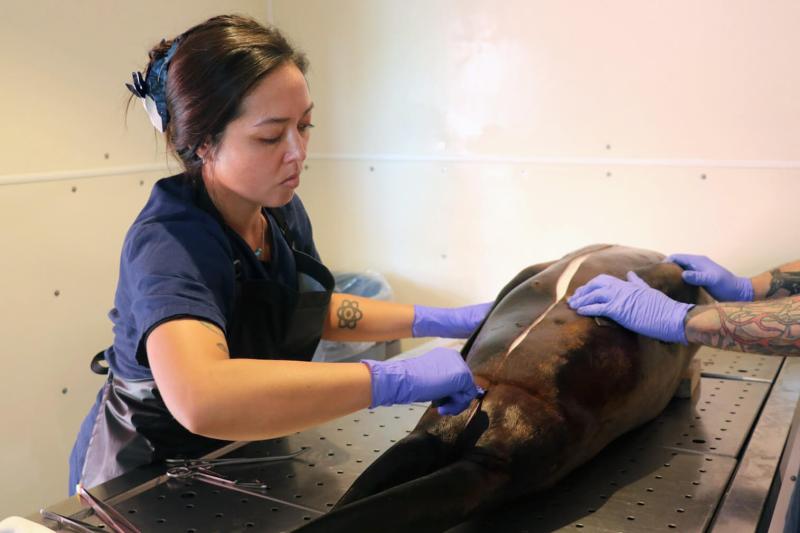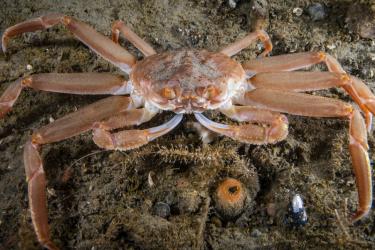On April 12, 2025, Cristina Robinson and her team responded to a call in Huntington Beach, California as beachgoers came across a beached gray whale. This gray whale became a sensation in regional news by attracting a crowd to a popular Southern California beach, often frequented by locals and tourists. One TikToker filmed Robinson educating the public about her team’s response in a video garnering more than 421,000 likes. Pacific Marine Mammal Center’s necropsy team, including Cristina Robinson, was onsite. They were collecting samples and providing information to the community about ocean conditions, whale health, and the importance of performing necropsies on stranded marine mammals.
As the Research and Necropsy Biologist at the Center, Robinson earlier this year found herself at the center of the worst domoic acid bloom event ever recorded in Southern California. At their facilities in Laguna Beach, she occasionally assists the rescue team before performing necropsies. Animal deaths and necropsies, or animal autopsies, are performed to understand what happened to an animal. They have sadly become a major part of her work week, especially during a severe harmful algal bloom that began earlier this year in February. Domoic acid is a potent neurotoxin produced by the harmful algae Pseudo-nitzschia, which can multiply rapidly into a “bloom” under certain environmental conditions. Fish that consume the algae producing this toxin pass it up the food chain, sickening marine mammals such as sea lions, dolphins, and even whales through bioaccumulation. The toxin becomes more potent with acute exposure. Affected animals may suffer from seizures on the beach, display abnormal behaviors like head bobbing, or die.
Marine Animals Affected by Domoic Acid
The Pacific Marine Mammal Center reported 422 animals animals affected by domoic acid as of June 2025.
- Adult California Sea Lions (Zalophus californianus): 283
- Fetus California Sea Lion (Zalophus californianus): 83
- Adult Common Dolphins (Delphinus delphis): 52
- Fetus Common Dolphins (Delphinus delphis): 2
- Humpback Whales (Megaptera novaeangliae): 1
“On average, the Pacific Marine Mammal Center responds to 150 to 200 marine mammal strandings a year. As a result of the largest domoic acid bloom in our region’s history, we have responded to more than 337 marine mammal strandings—just in the first half of 2025," reports Dr. Alissa Deming, vice president of conservation medicine and science for the Center. The Center is a part of the West Coast Marine Mammal Stranding Network, which NOAA Fisheries coordinates.
Facing so many sick and dying animals is emotionally draining, and Robinson does her best to stay strong. “I repeatedly tell myself that each sample collected from a deceased patient will help share their story after death—learning all we can from them, and using that information for research to help prevent other animals from meeting the same fate,” shares Robinson.
Cristina’s Journey
Robinson went to Golden West College and transferred to California State Long Beach to receive a Bachelor’s of Science in Marine Biology. Once she graduated, she worked several jobs as an environmental science educator, and volunteered with NOAA Fisheries West Coast Marine Mammal Stranding Network. Volunteering with NOAA allowed her to dive deeper into her passion for marine mammal response. As she pursued her Master’s Degree in Environmental Science & Management at the Bren School at UC Santa Barbara, she worked with the Protected Resource Division as a Pathways intern. “I always wanted to help protect marine mammals as they are such intelligent and incredible beings that reflect our health and what we are doing to the ocean,” shares Robinson. She has dedicated her life to not only protecting marine mammals, but also educating people about how to share resources with wildlife.
She hopes that doing the work and speaking to the public sparks curiosity in the ocean and all of its critters.
What Is a Necropsy?
A necropsy is a post-mortem examination of an animal’s body. The exam seeks to determine the cause of death or identify diseases that resulted in its death. Necropsy duration varies from several hours for smaller animals, to up to 3 days for whales. It can take quite a team to examine the animal and collect samples. Each necropsy and diagnostic investigation is a collaborative effort with other scientists and other organizations, such as the Ocean Animal Response and Research Alliance and the Marine Mammal Care Center Los Angeles.
During a necropsy, teams collect various samples to piece together what happened to the animal. These include, but are not limited to:
Histopathology Samples
Tissues fixed in formalin and sent to a histopathologist—a veterinarian with specialized training in pathology—who examines slides at the cellular level to determine disease or cause of death.
Contaminant Samples
Samples of specific tissues such as blubber, skeletal muscle, liver, and kidney are wrapped in aluminum foil to test later for pollutants. This is especially important during oil spills.
Frozen/Cryovial Samples
Various tissues and fluids (e.g., aqueous humor, cerebrospinal fluid, bile, urine, stomach contents, feces) are archived or used for collaborative research.
Special cases may require additional protocols—for example, when an animal has cancer-like masses or during domoic acid events, which call for prioritized tissue collection. These cases often involve more extensive photography and sample collection.
Necropsies are critical to understanding the impacts of these events on animal populations and overall ocean health. However, due to the sheer size of this domoic acid event, it was nearly impossible to conduct necropsies on all the animals that were stranded. Even so, many histopathology samples have yet to be processed for final determination of death.
A Memorable Necropsy
One of the most memorable domoic acid bloom necropsies that Robinson was involved in was a stranded subadult male minke whale in Long Beach, California. Its death was anticipated after the whale spent nearly a week swimming in circles close to the Long Beach Harbor, an abnormal behavior for minke whales. The public quickly became attached to the whale as they were able to view the animal up close and on TV news. Eventually, the minke whale died. and the Ocean Animal Response and Research Alliance led the necropsy along with Marine Mammal Care Center Los Angeles, and the Pacific Marine Mammal Center. The three teams collected more samples from this whale than were usually done for previous large whale necropsies.
“Being able to collaborate with our neighboring stranding networks on this necropsy was really special as it allowed us to collect more samples quickly while facing a rising tide where the whale washed ashore,” Robinson says. These samples ultimately confirmed that the minke whale suffered from domoic acid toxicosis. Robinson and her colleagues have noted that victims of domoic acid often have little to no stomach contents, as the neurotoxin causes animals to be too sick to forage for food.
How You Can Help
“This bloom being so strong and long-lasting has been incredibly challenging, both physically and emotionally,” Robinson says. She hopes that by sharing her story, the public will feel inspired to protect marine mammals and appreciate the wildlife and natural resources we all share.
While it is impossible to stop a domoic acid bloom entirely, community members can help preserve our oceans’ health by:
- Reducing and avoiding fertilizer use before a rainstorm
- Picking up after pets outside
- Limiting urban runoff into the ocean
You can also volunteer your time and support local organizations like the Center. Report stranded or sick marine mammals in Orange County to the Center at (949) 494-3050, ext. 9.
Report stranded sea lions, dolphins, or other marine mammals to the West Coast Region Stranding Hotline: (866) 767-6114. These reports allow the Stranding Network to get to an animal as soon as possible and provide them a higher chance of survival.







